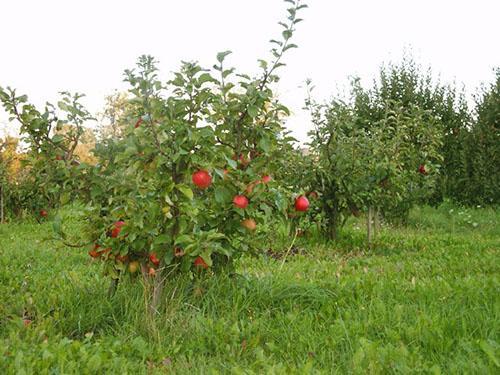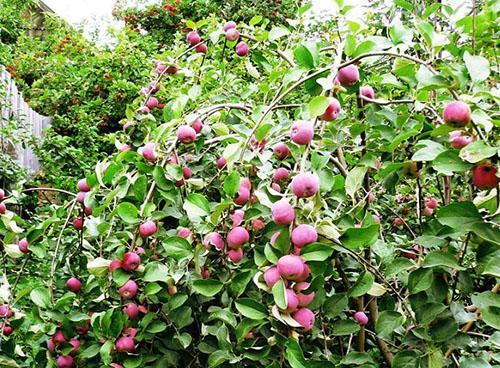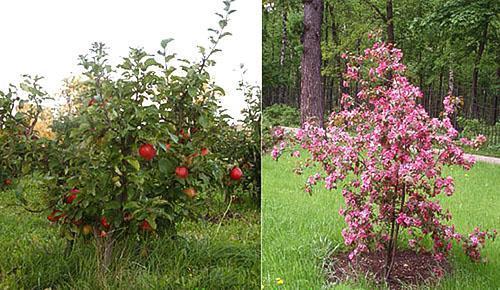Photos of dwarf apple trees and features of their cultivation
 Recently, dwarf apple trees are increasingly found in the garden plots of our country. They attract gardeners with their compactness and high yield, which is achieved due to the rapid growth of young trees and good development of the root system. Dwarf apple seedlings are bred in special garden nurseries, where they are obtained using a dwarf rootstock.
Recently, dwarf apple trees are increasingly found in the garden plots of our country. They attract gardeners with their compactness and high yield, which is achieved due to the rapid growth of young trees and good development of the root system. Dwarf apple seedlings are bred in special garden nurseries, where they are obtained using a dwarf rootstock.
Benefits of dwarf apple trees

- start to bear fruit early;
- have a high yield;
- due to its short stature, the main part of the nutrients is aimed at the formation of fruits, and not at the development of the trunk and branches;
- additional devices are not used for harvesting, which contributes to the preservation of an excellent presentation;
- due to the superficial location of the root system, dwarf varieties can be planted even in areas with a close location of groundwater.
All these factors contribute to the growing popularity of dwarf apple varieties among gardeners in Russia.
Read also the article:apple lungwort - description with photo!
How to distinguish dwarf apple trees from columnar ones?
 Very often dwarf apple trees are confused with columnar ones. But these are completely different forms of fruit trees. Dwarf apple trees are low-growing trees that have a spreading crown, up to 3 m in diameter.
Very often dwarf apple trees are confused with columnar ones. But these are completely different forms of fruit trees. Dwarf apple trees are low-growing trees that have a spreading crown, up to 3 m in diameter.
The main characteristic featurecolumnar apple trees is that this clone has a single-trunk crown with fairly short lateral branches. Outwardly, such an apple tree resembles a column covered with fruits from above, like sea buckthorn.
In order not to confuse dwarf and columnar apple seedlings when buying, you need to pay attention to the trunk and root. The trunk of a dwarf apple tree has branches that are absent in the columnar one. The root system of a dwarf apple tree is fibrous, and its elasticity and firmness indicates a good quality seedling. In a columnar apple tree, the root has a rod system.
Popular varieties of dwarf apple trees
Below are descriptions and photos of varieties of dwarf apple trees, which are especially popular with Russian gardeners.
Apple tree Melba
 A productive summer variety of Canadian origin. Main characteristics:
A productive summer variety of Canadian origin. Main characteristics:
- the height of the tree does not exceed 3 m;
- fruits are medium, weighing 150–250 g, rounded-elongated, the peel is bright green with a red blush;
- the pulp is snow-white, tender, juicy, with a caramel taste;
- ripening of fruits occurs in July - August;
- the yield is 40 kg per tree;
- fruits are perfectly preserved for 3 months;
- resistance to frost and diseases is average;
- the best pollinator for the variety is Borovinka and Suslepskoe.
Apple-tree Wonderful
 A late summer high-yielding variety that can be grown throughout Russia. Main characteristics:
A late summer high-yielding variety that can be grown throughout Russia. Main characteristics:
- the height of the tree is 2.8–3 m, with a small stem;
- fruits are medium, weighing 120–150 g, round, slightly ribbed, greenish-yellow rind with a rich dark red blush;
- the pulp is juicy, sweet and sour, has a fine-grained structure;
- ripening of fruits occurs in August - September;
- yield - about 75 kg per tree;
- fruit preservation is good within 2 months;
- trees are highly resistant to frost and scab;
- apple-tree Chudnoe - the best pollinator for other dwarf varieties. And Anis Sverdlovsky is the best pollinator for her.
Apple tree Zhigulevskoe
 Autumn high-yielding variety. Main characteristics:
Autumn high-yielding variety. Main characteristics:
- the height of the tree is 2–3 m;
- fruits are large, weighing 150–300 g, round, red-orange;
- the pulp is coarse, tender, creamy, sweet and sour;
- ripening period: September - October;
- yield - up to 120 kg per tree;
- fruits are perfectly stored for 6 months;
- the variety has good resistance to pests and diseases;
- the best pollinators are Welsey, Autumn striped.
Landing features
 Based on the recommendations of experienced gardeners, planting apple trees on a dwarf rootstock best done in autumn. During the winter, the root system will get stronger, so in the spring the trees will begin to actively grow and develop. You can also plant seedlings in spring. But in this case, you need to have time to plant before budding, otherwise the trees may dry out.
Based on the recommendations of experienced gardeners, planting apple trees on a dwarf rootstock best done in autumn. During the winter, the root system will get stronger, so in the spring the trees will begin to actively grow and develop. You can also plant seedlings in spring. But in this case, you need to have time to plant before budding, otherwise the trees may dry out.
As a rule, one- and two-year-old trees are planted. Planting dwarf apple trees includes the following steps:
- Planting pits are prepared, 50 cm wide and deep. When digging a hole, the top layer of soil is placed on the right side, and the bottom layer on the left.
- 1 bucket of humus is placed in the pit, mineral fertilizer, nitrophoska and part of the upper soil layer. All these components are carefully mixed. If the soil is clayey and heavy, then add some more sand.
- The roots of the seedlings are well straightened, the tree is fixed in the hole and covered first with the upper layer of soil, and then with the lower one.
- The soil is lightly compacted. In this case, the seedlings are deepened so that the grafts are at a distance of 5–7 cm from the soil.
- Holes are made around the trunk, and the seedling is watered.
- The near-trunk area is mulched with soil or humus.
If there is a possibility of strong winds, then it is recommended to tie the seedling to a support.
Caring for apple trees on a dwarf rootstock
 Proper care of dwarf apple trees includes:
Proper care of dwarf apple trees includes:
- watering;
- top dressing;
- pruning.
In the summer, apple trees on a dwarf rootstockwatered 1 time in 7 days, at the rate of 10 liters of water for each tree. After watering, the soil must be loosened.
Top dressing is carried out 2 times per summer. To do this, you can use chicken manure diluted with water in a ratio of 1:20, or cow dung in a ratio of 1:10.
In the first year, it is imperative to carry out pruning to form the lower part of the crown. In subsequent years, only regular pruning of increments is carried out.
How to shape an apple tree?
 It is recommended to form a crown 1 year after planting, in autumn or spring, but before the active growth of branches begins. How to shape an apple tree? To do this, cut its top with a pruner at a height of 40-60 cm from the ground and process the cut with garden pitch.
It is recommended to form a crown 1 year after planting, in autumn or spring, but before the active growth of branches begins. How to shape an apple tree? To do this, cut its top with a pruner at a height of 40-60 cm from the ground and process the cut with garden pitch.
 Like any other tree, the branches of dwarf apple trees develop unevenly. And strong branches tend to interfere with the development of weak and fragile branches. Therefore, when forming the crown, you need to ensure that strong branches are located at the bottom, and fragile ones at the top. This is achieved by pruning the upper, vigorous branches.
Like any other tree, the branches of dwarf apple trees develop unevenly. And strong branches tend to interfere with the development of weak and fragile branches. Therefore, when forming the crown, you need to ensure that strong branches are located at the bottom, and fragile ones at the top. This is achieved by pruning the upper, vigorous branches.
To increase the diameter of the crown, young branches must be directed outward when pruning. In this case, the tree will grow compact, and its branches will not sag.
During the period of fruit formation, the growth of branches is greatly weakened, and they begin to overload. Therefore, it is necessary to cut off the growth more so that the apple tree remains strong and young for longer, and the fruits do not decrease in size.
If all these recommendations are followed, the tree will always have a beautiful appearance and bring a good harvest.